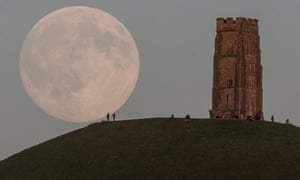Although the full moon on July 31, 2015, will look like an ordinary full moon, it's actually a bit extraordinary—a blue moon.
What is a Blue Moon?
There are in fact two definitions for a blue moon. According to the more recent definition, a blue moon is the second full moon in a calendar month. For a blue moon to occur, the first of the full moons must appear at or near the beginning of the month so that the second will fall within the same month (the average span between two moons is 29.5 days).
Blue moon: how to see tonight’s 'rare' event
Tonight’s blue moon will be easy to see, but the name has nothing to do with its colour and ‘once in a blue moon’ is probably based on a misunderstanding
Tonight’s blue moon will be easy to see, but the name has nothing to do with its colour and ‘once in a blue moon’ is probably based on a misunderstanding.
It will be shining in the reflected light of the Sun, as normal, and will appear yellow/white, as normal, yet we call it a blue moon because, well … here’s where the story gets interesting.
Most definitions say that a blue moon is the second full moon in a calendar month. This year, July’s first full moon was on the 2nd. Because there are 29.5 days between full moons (known as the lunar month), here we are again at full moon on 31st.
However, this definition is the result of a simplification made by amateur astronomer James Hugh Pruett writing in the 3 March 1946 issue of Sky & Telescope magazine. He wrote about blue moons, explaining that they occur seven times every 19 years because the lunar month is shorter than most of our familiar calendrical months. So sometimes there are 13 full moons in a year instead of 12. On these occasions, he concluded, “This gives 11 months with one full moon each and one with two. This second in a month, so I interpret it, was called Blue Moon.”
Simple but wrong. The term “blue moon” was introduced by the Maine Farmers’ Almanac, sometime after 1800. In their definition, the name was given to the third full moon in a season containing four. So, it could just as well be the first full moon in a month as the second.
We are probably familiar with the term “harvest moon”. This is the name given to the late September/early October full moon because it was said to light farmers’ fields allowing them to work into the night at harvest time.
In fact, all the full moons have names. They derive from the Native American Algonquin people. Aligned to the month they fall in, they are:
Most definitions say that a blue moon is the second full moon in a calendar month. This year, July’s first full moon was on the 2nd. Because there are 29.5 days between full moons (known as the lunar month), here we are again at full moon on 31st.
However, this definition is the result of a simplification made by amateur astronomer James Hugh Pruett writing in the 3 March 1946 issue of Sky & Telescope magazine. He wrote about blue moons, explaining that they occur seven times every 19 years because the lunar month is shorter than most of our familiar calendrical months. So sometimes there are 13 full moons in a year instead of 12. On these occasions, he concluded, “This gives 11 months with one full moon each and one with two. This second in a month, so I interpret it, was called Blue Moon.”
Simple but wrong. The term “blue moon” was introduced by the Maine Farmers’ Almanac, sometime after 1800. In their definition, the name was given to the third full moon in a season containing four. So, it could just as well be the first full moon in a month as the second.
We are probably familiar with the term “harvest moon”. This is the name given to the late September/early October full moon because it was said to light farmers’ fields allowing them to work into the night at harvest time.
In fact, all the full moons have names. They derive from the Native American Algonquin people. Aligned to the month they fall in, they are:
This is truly rare and unpredictable. In 1883, the eruption of Krakatoa give the Moon a bluish tinge for almost two years.
When looking at the Moon tonight, however, perhaps don’t think about the vagaries of definitions and phase. Wonder instead at the celestial object’s beauty, and the fact that 46 years ago this month, Neil Armstrong and Buzz Aldrin became the first humans to walk on it.

1 टिप्पणी:
रोचक जानकारी..
एक टिप्पणी भेजें